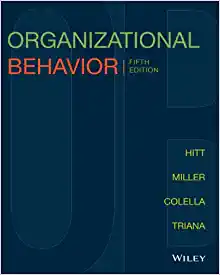The behaviors this instrument conjures as notes of leadership behavior are worth remembering. They are surfaced so
Question:
The behaviors this instrument conjures as notes of leadership behavior are worth remembering. They are surfaced so that your learners may detect and discriminate between transactional and transformational, passive-avoidant behaviors by those they would follow. Here is an exercise to more deeply imprint these leadership markers. It is called “Never a Sour Note?” to remind learners to recall this assessment as music.
In music, a note is a tone of definite pitch. There can be a characteristic tone used as a symbol for each leadership behavior that is being “played” to attract a followership: charisma, intellectual stimulation, individualized consideration, contingent reward behavior, management-by-exception behavior, and laissez-faire management behavior. Each of these behaviors or tones elicits a particular quality or emotion: charisma, a note of hope; passive management behavior, a note of despair.
When acts of leading are wrong for the person in the moment and context that are behaved, it strikes a sour note. A practical use of the exercise that follows is for learners to notice leadership going wrong and to check their responses accordingly. One may be experiencing transformational leadership, for example, that rather than feeling right, sets one’s teeth on edge, as a misplayed trumpet note might. It would be like catching a manipulative, contingent reward behavior hidden underneath dulcet tones of individualized consideration. Your learner is told that a leader can be both transformational and transactional, but can a leader be both at the same time?
Questions:
1. The object is for teams to create musical riffs for each of the six aspects of leading. A riff in music is a short rhythmic phrase, especially one repeated in improvisation. In conversation, a riff is a clever or inventive commentary or remark. Blended, the creative task is to invent clever little tunes conveying what each leadership behavior means (sounds like) to those whom the influencing is directed. The team will hum these for the class. There is no time to set the tunes to words, but if there were, it would deepen the fun and recollection.
2. Trust the creativity and musical ear of your learners.
3. Do this one item at a time.
a. Write the word “Charisma” on the board.
b. Have them review descriptors 1-12 on the instrument.
c. Give them just a few minutes for each team to come up with a tune.
d. Have them hum the tune together as a chorus, then have a spokesperson explain what mood and meaning they were going for.
4. Repeat this for the other five leadership markers.
5. See if they can recall the tunes of each or any of the six invented by their teams and/or other teams. The point of this is recollection.
6. Invite them to practice this new art of listening for the sweet and sour notes of leadership as they are experiencing it.
Step by Step Answer:






